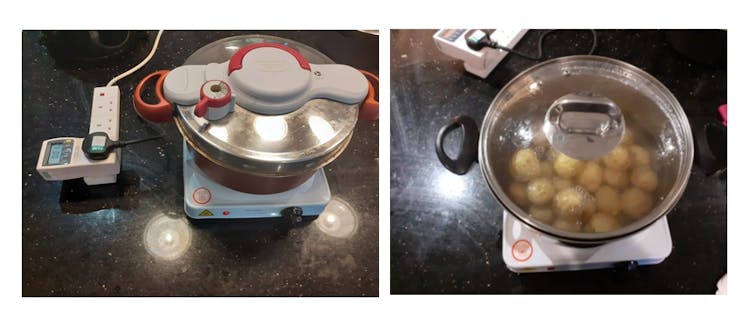If you take a close look at the energy vampires in any home, there is one common denominator: heat. This means that cooking can be one of the biggest costs, along with electric heaters and water heating. washing and radiators. So what are the most effective things you can do in the kitchen to lower your energy bills?
I conducted a series of small experiments at home to compare the energy-saving characteristics of various appliances and ordinary stoves.
The economy and payback period of all subsequent changes will depend on power, fuel and technology. But overall, using more efficient kitchen technology will lower your home energy bills.
To understand the results of my research on pasta, rice and potatoes, let’s look at the basics of energy intake. Whether you have gas or electricity, energy use is measured in kilowatt-hours (kWh). Boiling ten liters of water in a kettle from room temperature consumes about 1 kWh. A 1 kW (1000 W) electric heater will consume 1 kWh in one hour.
Chips: The air fryer wins
My air fryer uses about 68% of the electricity my oven uses. I made 500g of chips in the oven, frozen at 200℃. The air fryer consumed 0.43 kWh and cooked in 18 minutes, while the electric oven consumed 1.35 kWh and required 32 minutes. This can be explained by the large size of the oven and the fact that it requires preheating.
An air fryer could save a UK household around £114 a year, assuming 500g of crisps are cooked every day. It is based on electricity and gas prices £0.34 and £0.10 per kWh respectively, the prices set by the October 2022 energy price cap.

Rice and Pasta: The thermos stove wins
The thermos stove used just 0.03kWh to boil 200ml of water and cook 150g of rice, which took two hours (for one person). A typical pan took only 15 minutes, but ate up 0.18kWh. The thermos stove saved 83.3% of energy. The financial savings will be around £74 for 600g of rice per day for one year.
When cooking pasta per serving per person, the energy required to boil water was 0.09 kWh and the pasta was cooked in 30 minutes. A normal pot used 0.26 kWh of electricity to cook the same pasta. This is a 65.4% energy saving. The saving would be around £84 for a family of four based on one meal a day.

Potatoes: The pressure cooker wins
I boiled 1 kg of potatoes in each test and used electricity. The regular pot used 0.65 kWh and took 30 minutes, the pressure cooker used 0.42 kWh in 20 minutes, and the slow cooker needed about 0.59 kWh and cooked the potatoes in two hours.
The cost savings of using a pressure cooker in the UK will be around £28.50 per year on electricity. For a slow cooker, the savings will be £7.40 a year, but more if cooking at lower temperatures for longer. However, if you have a gas stove, a pressure cooker can save you up to 81% on energy costs compared to a regular pot.
Payback period
Based on average current market prices; it costs around £15 to buy a small thermos (£100 for a family size), £70 for a home fryer, £50 for a pressure cooker and £35 for a slow cooker.
Assume that a family will cook one meal a day for a year. For a deep fryer compared to an electric oven, the payback period for oven chips per meal per day is about seven months. After investing £70, you won’t see any real savings for seven months. But then you save £114 a year.

There are other things you can do to reduce your cooking costs.
Efficient cooking is about heating the food, not the kitchen. The image below is an infrared image showing heat loss when cooking pasta in a regular pot. A huge amount of energy escapes from the walls of the pan, instead of heating up your dinner.

Gas ovens are cheaper
Think about energy prices in the country where you live. In the UK, gas prices are around 30% of the cost of electricity and the daily fixed charge is only around 60% of the fixed electricity charge, based on October 2022 prices.
So, for the same amount of heat, using a gas oven should theoretically be about 70% cheaper. Electrical equipment is more efficient because heat is more efficiently distributed and controlled. But who is the consumer champion? estimated consumption of electricity double the cost of gas for cooking in the oven.
Induction stoves are superior to conventional electric ones
It’s a different matter for the stove. Electric induction cooktops use a magnetic field to heat pans directly. Induction hobs save energy in two ways. The stove itself does not heat up, so it does not lose heat. And the heat is transferred through the magnetic field to the pot without heat leakage to the surroundings. But you will need pans made of black metal.
Do not increase the heat while the liquid is boiling
As a final tip, remember that using high temperatures for already boiling liquids will not cook the food any faster, as the temperature the liquid will not change. If you like boiled eggs for breakfast, as soon as the water boils, reduce the heat.
https://theconversation.com/air-fryers-and-pressure-cookers-how-you-can-save-money-on-your-cooking-bills-192303



